Peace Corps
The Peace Corps is a volunteer program run by the United States government. Its official mission is to provide social and economic development abroad through technical assistance, while promoting mutual understanding between Americans and populations served. The program was established by Executive Order 10924, issued by President John F. Kennedy on March 1961 and authorized by Congress on September 21, 1962 with passage of the Peace Corps Act (Pub.L. 87–293).
 | |
| Agency overview | |
|---|---|
| Formed | March 1, 1961 |
| Headquarters | Washington, D.C., U.S. |
| Annual budget | $398 million (2018 fiscal year)[1] |
| Agency executive |
|
| Parent agency | US Government |
| Website | www |
Peace Corps Volunteers are American citizens, typically with a college degree, who work abroad for a period of two years after three months of training. Volunteers work with governments, schools, non-profit organizations, non-government organizations, and entrepreneurs in education, youth development, community health, business, information technology, agriculture, and the environment. After 24 months of service, volunteers can request an extension of service.[2]
Since its inception, more than 235,000 Americans have joined the Peace Corps and served in 141 countries.[3] In 2020, due to the coronavirus pandemic all volunteers were evacuated from all posts. There are currently no volunteers serving at this time.[4]
History
1950–1959
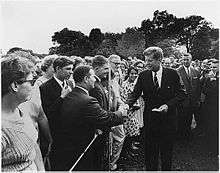
Following the end of World War II, various members of the United States Congress proposed bills to establish volunteer organizations in developing countries. In December 1951 Representative John F. Kennedy (D-Massachusetts) suggested to a group that "young college graduates would find a full life in bringing technical advice and assistance to the underprivileged and backward Middle East ... In that calling, these men would follow the constructive work done by the religious missionaries in these countries over the past 100 years."[6]:337–338 In 1952 Senator Brien McMahon (D-Connecticut) proposed an "army" of young Americans to act as "missionaries of democracy".[7] Privately funded nonreligious organizations began sending volunteers overseas during the 1950s. While Kennedy is credited with the creation of the Peace Corps as president, the first initiative came from Senator Hubert H. Humphrey, Jr. (D-Minnesota), who introduced the first bill to create the Peace Corps in 1957—three years before Kennedy, as a presidential candidate, would raise the idea during a campaign speech at the University of Michigan. In his autobiography The Education of a Public Man, Humphrey wrote,
There were three bills of particular emotional importance to me: the Peace Corps, a disarmament agency, and the Nuclear Test Ban Treaty. The President, knowing how I felt, asked me to introduce legislation for all three. I introduced the first Peace Corps bill in 1957. It did not meet with much enthusiasm. Some traditional diplomats quaked at the thought of thousands of young Americans scattered across their world. Many senators, including liberal ones, thought it silly and an unworkable idea. Now, with a young president urging its passage, it became possible and we pushed it rapidly through the Senate. It is fashionable now to suggest that Peace Corps Volunteers gained as much or more, from their experience as the countries they worked. That may be true, but it ought not demean their work. They touched many lives and made them better.[8]
Only in 1959, however, did the idea receive serious attention in Washington when Congressman Henry S. Reuss of Wisconsin proposed a "Point Four Youth Corps". In 1960, he and Senator Richard L. Neuberger of Oregon introduced identical measures calling for a nongovernmental study of the idea's "advisability and practicability". Both the House Foreign Affairs Committee and the Senate Foreign Relations Committee endorsed the study, the latter writing the Reuss proposal into the pending Mutual Security legislation. In this form it became law in June 1960. In August the Mutual Security Appropriations Act was enacted, making available US$10,000 for the study, and in November ICA contracted with Maurice Albertson, Andrew E. Rice, and Pauline E. Birky of Colorado State University Research Foundation[9] for the study.[10][11]
1960–1969
John F. Kennedy was the first to announce the idea for such an organization during the 1960 presidential campaign, on October 14, 1960, at a late-night speech at the University of Michigan in Ann Arbor on the steps of the Michigan Union.[12] He later dubbed the proposed organization the "Peace Corps." A brass marker commemorates the place where Kennedy stood. In the weeks after the 1960 election, the study group at Colorado State University released their feasibility a few days before Kennedy's Presidential Inauguration in January 1961.[13]
Critics opposed the program. Kennedy's opponent, Richard M. Nixon, predicted it would become a "cult of escapism" and "a haven for draft dodgers."[14][15][16]
Others doubted whether recent graduates had the necessary skills and maturity for such a task. The idea was popular among students, however, and Kennedy pursued it, asking respected academics such as Max Millikan and Chester Bowles to help him outline the organization and its goals. During his inaugural address, Kennedy again promised to create the program: "And so, my fellow Americans: ask not what your country can do for you—ask what you can do for your country".[17] President Kennedy in a speech at the White House on June 22, 1962, "Remarks to Student Volunteers Participating in Operation Crossroads Africa", acknowledged that Operation Crossroads for Africa was the basis for the development of the Peace Corps. "This group and this effort really were the progenitors of the Peace Corps and what this organization has been doing for a number of years led to the establishment of what I consider to be the most encouraging indication of the desire for service not only in this country but all around the world that we have seen in recent years".[18] The Peace Corps website answered the question "Who Inspired the Creation of the Peace Corps?", acknowledging that the Peace Corps were based on Operation Crossroads Africa founded by Rev. James H. Robinson.[19]
On March 1, 1961, Kennedy signed Executive Order 10924 that officially started the Peace Corps. Concerned with the growing tide of revolutionary sentiment in the Third World, Kennedy saw the Peace Corps as a means of countering the stereotype of the "Ugly American" and "Yankee imperialism," especially in the emerging nations of post-colonial Africa and Asia.[20][21] Kennedy appointed his brother-in-law, Sargent Shriver, to be the program's first director. Shriver fleshed out the organization with the help of Warren Wiggins and others.[9] Shriver and his think tank outlined the organization's goals and set the initial number of volunteers. The Peace Corps began recruiting in July 1962; Bob Hope cut radio and television announcements hailing the program.
A leading Peace Corps critic was U.S. Representative Otto Passman of Louisiana's 5th congressional district, based about Monroe. Critics called Passman "Otto the Terrible" for trying to thwart the program by reducing its funding to minimal levels. Ultimately, it would be President Nixon, who despite his previous skepticism rescued the Peace Corps after 1969 from Passman's congressional knife.[22]
Until about 1967, applicants had to pass a placement test of "general aptitude" (knowledge of various skills needed for Peace Corps assignments) and language aptitude. After an address from Kennedy, who was introduced by Rev. Russell Fuller of Memorial Christian Church, Disciples of Christ, on August 28, 1961, the first group of volunteers left for Ghana and Tanzania, known as Tanganyika at the time.[23] The program was formally authorized by Congress on September 22, 1961, and within two years over 7,300 volunteers were serving in 44 countries. This number increased to 15,000 in June 1966, the largest number in the organization's history.[24]
The organization experienced controversy in its first year of operation. On October 13, 1961, a postcard from a volunteer named Margery Jane Michelmore in Nigeria to a friend in the U.S. described her situation in Nigeria as "squalor and absolutely primitive living conditions."[25][26] However, this postcard never made it out of the country.[26] The University of Ibadan College Students Union demanded deportation and accused the volunteers of being "America's international spies" and the project as "a scheme designed to foster neocolonialism."[27] Soon the international press picked up the story, leading several people in the U.S. administration to question the program.[28] Nigerian students protested the program, while the American volunteers sequestered themselves and eventually began a hunger strike.[26] After several days, the Nigerian students agreed to open a dialogue with the Americans.
Policies
The theme of enabling Americans to volunteer in poor countries appealed to Kennedy because it fit in with his campaign themes of self-sacrifice and volunteerism, while also providing a way to redefine American relations with the Third World. Upon taking office, Kennedy issued an executive order establishing the Peace Corps, and he named his brother-in-law, Sargent Shriver, as the agency's first director. Shriver, not Kennedy, energetically lobbied Congress for approval. Kennedy proudly took the credit, and ensured that it remained free of CIA influence. He largely left its administration to Shriver. To avoid the appearance of favoritism to the Catholic Church, the Corps did not place its volunteers with any religious agencies.[29] In the first twenty-five years, more than 100,000 Americans served in 44 countries as part of the program. Most volunteers taught English in local schools, but many became involved in activities like construction and food delivery. Shriver practiced affirmative action, and women comprised about 40 percent of the first 7000 volunteers. However given the paucity of black college graduates, racial minorities never reached five percent. The Corps developed its own training program, based on nine weeks at an American university, with a focus on conversational language, world affairs, and desired job skills.[30] That was followed by three weeks at a Peace Corps camp in Puerto Rico, and week or two of orientation the home and the host country.[31] [32]
1970–1999
In July 1971, President Richard Nixon, an opponent of the program,[14][15][16] brought the Peace Corps under the umbrella agency ACTION. President Jimmy Carter, an advocate of the program, said that his mother, who had served as a nurse in the program, had "one of the most glorious experiences of her life" in the Peace Corps.[33] In 1979, he made it fully autonomous in an executive order. This independent status was further secured by 1981 legislation making the organization an independent federal agency.
In 1976, Deborah Gardner was found murdered in her home in Tonga, where she was serving in the Peace Corps. Dennis Priven, a fellow Peace Corps worker, was later charged with the murder by the Tonga government.[34] He was found not guilty by reason of insanity, and was sentenced to serve time in a mental institution in Washington D.C. Priven was never admitted to any institution, and the handling of the case has been heavily criticized. The main criticism has been that the Peace Corps seemingly worked to keep one of its volunteers from being found guilty of murder, due to the reflection it would have on the organization.[35]
2000–present
Although the earliest volunteers were typically thought of as generalists, the Peace Corps had requests for technical personnel from the start. For example, geologists were among the first volunteers requested by Ghana, an early volunteer host. An article in Geotimes (a trade publication) in 1963, reviewed the program, with a follow-up history of Peace Corps geoscientists appearing in that publication in 2004.[36] During the Nixon Administration the Peace Corps included foresters, computer scientists, and small business advisers among its volunteers.
In 1982, President Ronald Reagan appointed director Loret Miller Ruppe, who initiated business-related programs. For the first time, a significant number of conservative and Republican volunteers joined the Corps, as the organization continued to reflect the evolving political and social conditions in the United States. Funding cuts during the early 1980s reduced the number of volunteers to 5,380, its lowest level since the early years. Funding increased in 1985, when Congress began raising the number of volunteers, reaching 10,000 in 1992.
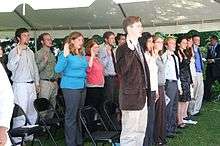
After the 2001 September 11 attacks, which alerted the U.S. to growing anti-U.S. sentiment in the Middle East, President George W. Bush pledged to double the size of the organization within five years as a part of the War on Terrorism. For the 2004 fiscal year, Congress increased the budget to US$325 million, US$30 million above that of 2003 but US$30 million below the President's request.
As part of an economic stimulus package in 2008, President Barack Obama proposed to double the size of the Peace Corps.[37] However, as of 2010, the amount requested was insufficient to reach this goal by 2011. In fact, the number of applicants to the Peace Corps declined steadily from a high of 15,384 in 2009 to 10,118 in 2013.[38] Congress raised the 2010 appropriation from the US$373 million requested by the President to US$400 million, and proposed bills would raise this further for 2011 and 2012.[39] According to former director Gaddi Vasquez, the Peace Corps is trying to recruit more diverse volunteers of different ages and make it look "more like America".[40] A Harvard International Review article from 2007 proposed to expand the Peace Corps, revisit its mission, and equip it with new technology.[41] In 1961 only 1% of volunteers were over 50, compared with 5% today. Ethnic minorities currently comprise 19% of volunteers.[42] 35% of the U.S. population are Hispanic or non-White.[43]
In 2009, Casey Frazee, who was sexually assaulted while serving in South Africa, created First Response Action, an advocacy group for a stronger Peace Corps response for volunteers who are survivors or victims of physical and sexual violence.[44][45] In 2010, concerns about the safety of volunteers were illustrated by a report, compiled from official public documents, listing hundreds of violent crimes against volunteers since 1989.[46] In 2011, a 20/20 investigation found that "more than 1,000 young American women have been raped or sexually assaulted in the last decade while serving as Peace Corps volunteers in foreign countries."[47]
In a historic first, all Peace Corps volunteers worldwide were withdrawn from their host countries on March 15, 2020, due to the 2019–20 coronavirus pandemic. Volunteers were not eligible for unemployment or health benefits, although some Members of Congress said they should be. Legislators also called upon FEMA to hire Peace Corps volunteers until the end of their service.[48]
International presence
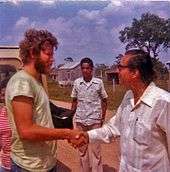
During its history, Peace Corps volunteers have worked in the following countries:[51]
Latin America and the Caribbean (23% of volunteers serve here, 2019)







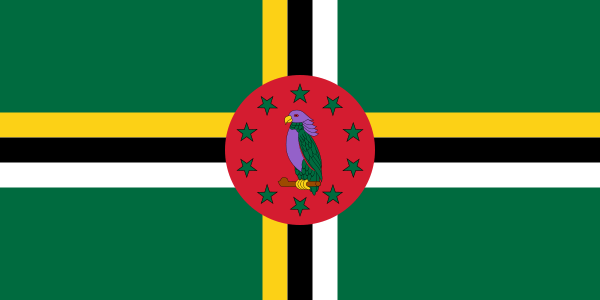








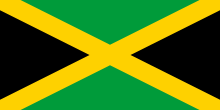










Europe and central Asia (13% of volunteers serve here, 2019)















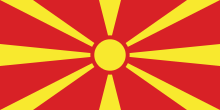










Middle East and north Africa (3% of volunteers serve here, 2019)

.svg.png)




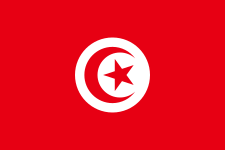

Subsaharan Africa (46% of volunteers serve here, 2019)












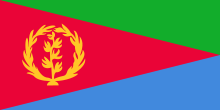












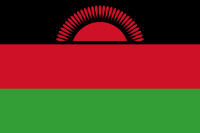





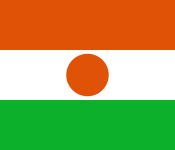














Asia (11% of volunteers serve here, 2019)
















Oceania (5% of volunteers serve here, 2019)

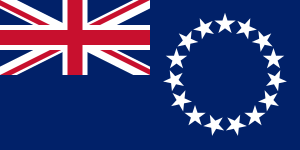








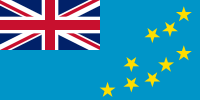

Application and volunteer process
The application for the Peace Corps takes up to one hour, unless one talks to a recruiter. The applicant must be at least 18 years old and a U.S. citizen and, according to a 2018 document, they should apply 6 to 9 months before they want to leave. They must go through an interview.[60]
Applicants can apply to only one placement every year. Placements can be sorted through the Peace Corps six project sectors: Agriculture, Environment, Community Economic Development, Health, Education, and Youth in Development. Applicants may also narrow down their application of choice by country they want to serve in various regions of the world.
Peace Corps volunteers are expected to serve for 2 years in the foreign country, with 3 months of training before swearing in to service. This occurs in country with host country national trainers in language and assignment skills.
Prior to 2014, the application process took about a year.[61]
Initiatives
The Peace Corps aims to educate community members on the different illnesses that are present in developing countries as well as what treatments exist in order prevent these illnesses from spreading. Volunteers are also often there in order to teach community members about modern agricultural techniques in order for them to more effectively produce food for themselves and each other (Peace Corps). The Corps is also a proponent of equal education and moves to allow for equal education opportunities for girls in countries like Liberia and Ethiopia. In 2015, the organization partnered with United States Agency for International Development (USAID) to implement First Lady Michelle Obama's Let Girls Learn initiative.[62]
Eradicating malaria in Africa
The Corps launched its initiative to engage volunteers in malaria control efforts in 2011. The initiative, which grew out of malaria prevention programs in Peace Corps Senegal, now includes volunteers in 24 African countries.[63][64]
Environment
The Corps offers a variety of environmental programs. Needs assessments determine which programs apply to each country. Programs include effective and efficient forms of farming, recycling, park management, environmental education, and developing alternative fuel sources.[65] Volunteers must have some combination of academic degrees and practical experience.
The three major programs are Protected-Areas Management, Environment Education or Awareness, and Forestry.
In Protected areas management, volunteers work with parks or other programs to teach resource conservation. Volunteer activities include technical training, working with park staff on wildlife preservation, organizing community-based conservation programs for sustainable use of forests or marine resources, and creating activities for raising revenue to protect the environment.
Environment Education or Awareness focuses on communities that have environmental issues regarding farming and income. Programs include teaching in elementary and secondary schools; environmental education to youth programs; creation of environmental groups; support forest and marine resource sustainability; ways of generating money; urban sanitation management; and educating farmers about soil conservation, forestry, and vegetable gardening.[66]
Forestry programs help communities conserve natural resources through projects such as soil conservation, flood control, creation of sustainable fuels, agroforestry (e.g., fruit and vegetable production), alley cropping, and protection of biodiversity.[67]
Peace Corps Response
Peace Corps Response, formerly named the Crisis Corps, was created by Peace Corps Director Mark Gearan in 1996.[68] Gearan modeled the Crisis Corps after the National Peace Corps Association's successful Emergency Response Network (ERN) of Returned Peace Corps Volunteers willing to respond to crises when needed. ERN emerged in response to the 1994 Rwandan genocide.[69] On November 19, 2007 Peace Corps Director Ronald Tschetter changed Crisis Corps's name to Peace Corps Response.[70]
The change to Peace Corps Response allowed Peace Corps to include projects that did not rise to the level of a crisis. The program deploys former volunteers on high-impact assignments that typically range from three to twelve months in duration.
Peace Corps Response volunteers generally receive the same allowances and benefits as their Peace Corps counterparts, including round-trip transportation, living and readjustment allowances, and medical care. Minimum qualifications include completion of at least one year of Peace Corps service, including training, in addition to medical and legal clearances. The Crisis Corps title was retained as a unique branch within Peace Corps Response, designed for volunteers who are deployed to true "crisis" situations, such as disaster relief following hurricanes, earthquakes, floods, volcanic eruptions and other catastrophes.
Laws governing the Peace Corps
Executive orders
Peace Corps was originally established by Executive Order, and has been modified by several subsequent executive orders including:
- 1961 – Executive Order 10924 – Establishment and administration of the Peace Corps in the Department of State (Kennedy)[73]
- 1962 – Executive Order 11041 – Continuance and administration of the Peace Corps in the Department of State (Kennedy)[74]
- 1963 – Executive Order 11103 – Providing for the appointment of former Peace Corps volunteers to the civilian career services (Kennedy)[75]
- 1971 – Executive Order 11603 – Assigning additional functions to the Director of ACTION (Nixon)
- 1979 – Executive Order 12137 – The Peace Corps (Carter)[76]
Laws
Federal laws governing the Peace Corps are contained in Title 22 of the United States Code – Foreign Relations and Intercourse, Chapter 34 – The Peace Corps.[77]
Public laws are passed by Congress and the President and create or modify the U.S. Code. The first public law establishing Peace Corps in the US Code was The Peace Corps Act passed by the 87th Congress and signed into law on September 22, 1961. Several public laws have modified the Peace Corps Act, including:
- Pub.L. 87–293, 75 Stat. 612, enacted September 22, 1961 – The Peace Corps Act
- Pub.L. 88–200, 77 Stat. 359, enacted December 13, 1963
- Pub.L. 89–134, 79 Stat. 549, enacted August 24, 1965
- Pub.L. 89–554, 80 Stat. 378, enacted September 6, 1966
- Pub.L. 89–572, 80 Stat. 764, enacted September 13, 1966
- Pub.L. 91–99, 83 Stat. 166, enacted October 29, 1969
- Pub.L. 91–352, 84 Stat. 464, enacted July 24, 1970
- Pub.L. 94–130, 89 Stat. 684, enacted November 14, 1975 – Bill to carry into effect certain provisions of the Patent Cooperation Treaty, and for other purposes.[78]
- Pub.L. 95–331, 92 Stat. 414, enacted August 2, 1978 – Peace Corps Act Amendments[79]
- Pub.L. 96–465, 94 Stat. 2071, enacted October 17, 1980 – The Foreign Service Act of 1980[80]
- Pub.L. 97–113, 95 Stat. 1519, enacted December 29, 1981 – International Security and Development Cooperation Act of 1981[81]
- Pub.L. 99–83, 99 Stat. 190, enacted August 8, 1985 – International Security and Development Cooperation Act of 1985[82]
- Pub.L. 99–514, 100 Stat. 2085, enacted October 22, 1986 – Tax Reform Act of 1986[83]
- Pub.L. 102–565, 106 Stat. 4265, enacted October 28, 1992 – A bill to amend the Peace Corps Act to authorize appropriations for the Peace Corps for FY1993 and to establish Peace Corps foreign exchange fluctuations account, and for other purposes.[84]
- Pub.L. 105–12, 111 Stat. 23, enacted April 30, 1997 – The Assisted Suicide Funding Restriction Act of 1997[85]
- Pub.L. 106–30, 113 Stat. 55, enacted May 21, 1999 – Peace Corps Act, FY2002, 2003 Authorization Bill[86]
- Peace Corps Reauthorization Act of 2008 at Congress.gov
Code of Federal Regulations
The Peace Corps is subject to Federal Regulations as prescribed by public law and executive order and contained in Title 22 of the Code of Federal Regulations under Chapter 3.
Limitations on former volunteers
Former members of the Peace Corps may not be assigned to military intelligence duties for a period of 4 years following Peace Corps service. Furthermore, they are forever prohibited from serving in a military intelligence posting to any country in which they volunteered.[87] Former members may not apply for employment with the Central Intelligence Agency for a period of 5 years following Peace Corps Service.
Time limits on employment
Peace Corps employees receive time-limited appointments, and most employees are limited to a maximum of five years of employment. This time limit was established to ensure that Peace Corps' staff remain fresh and innovative. A related rule specifies that former employees cannot be re-employed until after the same amount of time that they were employed. Volunteer service is not counted for the purposes of either rule.[88]
Union representation
Non-supervisory domestic employees are represented by the American Federation of State, County, and Municipal Employees (AFSCME) Local 3548. The Federal Labor Relations Agency certified the Union on May 11, 1983. About 500 domestic employees are members. The current collective bargaining agreement became effective on April 21, 1995.
Leadership
Directors
On January 3, 2018, President Donald Trump nominated Josephine "Jody" Olsen as the 20th director of the Peace Corps.[89] Olsen has a long history with the agency, serving as Acting Director in 2009, Deputy Director from 2002 to 2009, Chief of Staff from 1989 to 1992, Regional Director, North Africa Near East, Asia, Pacific from 1981 to 1984, and Country Director in Togo from 1979 to 1981. Olsen also served as a Peace Corps volunteer in Tunisia from 1966 to 1968.[89][90]
| Director | Service dates | Appointed by | Summary of Wikipedia page | |
|---|---|---|---|---|
| 1 | R. Sargent Shriver[91] | 1961–1966[91] | Kennedy[91] | President Kennedy appointed Shriver three days after signing the executive order.[92] Volunteers arrived in five countries during 1961.[93] In just under six years, Shriver developed programs in 55 countries with more than 14,500 volunteers.[92] |
| 2 | Jack Vaughn | 1966–1969 | Johnson | Vaughn improved marketing, programming, and volunteer support as large numbers of former volunteers joined the staff. He also promoted volunteer assignments in conservation, natural resource management, and community development. |
| 3 | Joseph Blatchford | 1969–1971 | Nixon | Blatchford served as head of the new ACTION agency, which included the Corps. He created the Office of Returned Volunteers to help volunteers serve in their communities at home, and initiated New Directions, a program emphasizing volunteer skills. |
| 4 | Kevin O'Donnell | 1971–1972 | Nixon | O'Donnell's appointment was the first for a former Peace Corps country director (Korea, 1966–70). He fought budget cuts, and believed strongly in a non-career Peace Corps. |
| 5 | Donald Hess | 1972–1973 | Nixon | Hess initiated training of volunteers in the host country where they would eventually serve, using host country nationals. The training provided more realistic preparation, and costs dropped for the agency. Hess also sought to end the down-sizing of the Peace Corps. |
| 6 | Nicholas Craw | 1973–1974 | Nixon | Craw sought to increase the number of volunteers in the field and to stabilize the agency's future. He introduced a goal-setting measurement plan, the Country Management Plan, which gained increased Congressional support and improved resource allocation across the 69 participating countries. |
| 7 | John Dellenback | 1975–1977 | Ford | Dellenback improved volunteer health care available. He emphasized recruiting generalists. He believed in committed applicants even those without specific skills and instead training them for service. |
| 8 | Carolyn R. Payton | 1977–1978 | Carter | Payton was the first female director and the first African American. She focused on improving volunteer diversity. |
| 9 | Richard F. Celeste | 1979–1981 | Carter | Celeste focused on the role of women in development and increased women and minority participation, particularly for staff positions. He invested heavily in training, including the development of a worldwide core curriculum. |
| 10 | Loret Miller Ruppe | 1981–1989 | Reagan | Ruppe was the longest-serving director and championed women in development roles. She launched the Competitive Enterprise Development program, the Caribbean Basin Initiative, the Initiative for Central America and the African Food Systems Initiative. |
| 11 | Paul Coverdell | 1989–1991 | G.H.W. Bush | Coverdell established two programs with a domestic focus. World Wise Schools enabled U.S. students to correspond with overseas volunteers. Fellows/USA assisted Returned Peace Corps volunteers in pursuing graduate studies while serving local communities. |
| 12 | Elaine Chao | 1991–1992 | G.H.W. Bush | Chao was the first Asian American director. She expanded Peace Corps' presence in Eastern Europe and Central Asia by establishing the first Peace Corps programs in Latvia, Lithuania, Estonia, and other newly independent countries. |
| 13 | Carol Bellamy | 1993–1995 | Clinton | Bellamy was the first RPCV (Returned Peace Corps volunteer) (Guatemala 1963–65) to be director. She reinvigorated relations with former volunteers and launched the Corps' web site. |
| 14 | Mark D. Gearan | 1995–1999 | Clinton | Gearan established the Crisis Corps, a program that allows former volunteers to help overseas communities recover from natural disasters and humanitarian crises. He supported expanding the corps and opened new volunteer programs in South Africa, Jordan, Bangladesh and Mozambique. |
| 15 | Mark L. Schneider | 1999–2001 | Clinton | Schneider was the second RPCV (El Salvador, 1966–68) to head the agency. He launched an initiative to increase volunteers' participation in helping prevent the spread of HIV/AIDS in Africa, and also sought volunteers to work on information technology projects. |
| 16 | Gaddi Vasquez | 2002–2006 | G.W. Bush | Gaddi H. Vasquez was the first Hispanic American director. His focus was to increase volunteer and staff diversity. He also led the establishment of a Peace Corps program in Mexico. |
| 17 | Ron Tschetter | September 2006 – 2008 | G.W. Bush | The third RPCV to head the agency, Tschetter served in India in the mid-1960s. He launched an initiative known as the "50 and Over," to increase the participation of older men and women. |
| 18 | Aaron S. Williams | August 2009 – September 2012 | Obama | Aaron S. Williams became director on August 24, 2009. Mr. Williams is the fourth director to have served as a volunteer. Williams cited personal and family considerations as the reason for his stepping down as Peace Corps Director on September 17, 2012.[94] |
| 19 | Carrie Hessler-Radelet | September 2012 – 2017 | Obama | Carrie Hessler-Radelet became acting Director of the Peace Corps in September 2012. Previously, Hessler-Radelet served as deputy director of the Peace Corps from June 23, 2010, until her appointment as acting Director.[95] From 1981–83, she served as a Peace Corps volunteer in Western Samoa with her husband, Steve. She was confirmed as Director on June 5, 2014. |
| 20 | Josephine K. Olsen | February 2018 – | Trump | Jody Olsen was confirmed Director of the Peace Corps on February 27, 2018. Olsen previously served the Peace Corps as Acting Director in 2009, Deputy Director from 2002 to 2009, Chief of Staff from 1989 to 1992, Regional Director, North Africa Near East, Asia, Pacific from 1981 to 1984, and Country Director in Togo from 1979 to 1981. Olsen also served as a Peace Corps volunteer in Tunisia from 1966 to 1968. |
Inspector General
The Peace Corps Office of Inspector General is authorized by law to review all programs and operations of the Peace Corps. The OIG is an independent entity within the Peace Corps. The inspector general (IG) reports directly to the Peace Corps Director. In addition, the IG reports to Congress semiannually with data on OIG activities. The OIG serves as the law enforcement arm of the Peace Corps and works closely with the Department of State, the Department of Justice, and other federal agencies OIG has three sections to conduct its functions:
Audit – Auditors review functional activities of the Peace Corps, such as contract compliance and financial and program operations, to ensure accountability and to recommend improved levels of economy and efficiency;
Evaluations – Evaluators analyze the management and program operations of the Peace Corps at both overseas posts and domestic offices. They identify best practices and recommend program improvements and ways to accomplish Peace Corps' mission and strategic goals.
Investigations – Investigators respond to allegations of criminal or administrative wrongdoing by Peace Corps Volunteers, Peace Corps personnel, including experts and consultants, and by those who do business with the Peace Corps, including contractors.[96]
From 2006–07, H. David Kotz was the Inspector General.[97]
Criticism
Critics and criticisms of Peace Corps include Robert L. Strauss of Foreign Policy,[98] an article by a former volunteer describing assaults on volunteers from 1992 to 2010,[99] an ABC news report on 20/20,[100] a Huffington Post article on former Peace Corps volunteers speaking out on rapes,[101] and About.com's article on rape and assault in the Peace Corps.[102]
In the Reagan Administration, in 1986, an article in the Multinational Monitor looked critically at the Peace Corps.[103] On a positive note, the writer praises the Corps for aspects saying that it is "not in the business of transferring massive economic resources. Rather it concentrates on increasing productivity and encouraging self-reliance in villages that are often ignored by large-scale development agencies," and notes the "heavy emphasis on basic education" by the Corps. "Many returned volunteers complain that the Peace Corps does little to promote or make use of their rich experiences once they return ... [A] Peace Corps volunteer is sent in ... [to] relieve ... the local government from having to develop policies that assure equitable distribution of health care ... During the early years there were many failures in structure and programming ... Some critics charge that the Peace Corps is only a somewhat ineffective attempt to counter damage done to the U.S. image abroad by its aggressive military and its unscrupulous businesses ... Many observers and some returned volunteers charge that, in addition to public relations for the United States, Peace Corps programs serve to legitimize dictators ... When he began evaluating the Corps in the 1960s, Charlie Peters found "they were training volunteers to be junior diplomats. Giving them a course in American studies, world affairs and communism ... Although it seems unlikely that the Peace Corps is used in covert operations, wittingly or not it is often used in conjunction with U.S. military interests ... In a review of the Peace Corps in March the House Select Committee on Hunger praised the agency for effective work in the areas of agriculture and conservation, while recommending that the Corps expand its African Food Systems Initiative, increase the number of volunteers in the field, recruit more women, and move to depoliticize country dictatorships."
The author suggests that "the poor should be encouraged to organize a power base to gain more leverage with the powers-that-be" by the Peace Corps and that "The Peace Corps is the epitome of Kennedy's Camelot mythology. It is a tall order to expect a small program appended to an immense superpower, to make a difference, but it is a goal worth striving for."
In December 2003, a report by the Brookings Institution praised the Peace Corps but proposed changes.[104] These include relabeling Peace Corps volunteers in certain countries, greater host country ownership, reverse volunteers (have volunteers from the host country in the U.S.), and multilateral volunteers. The Brookings Institution wrote that a "one-year service commitment [for the Baby Boom generation] could make the Peace Corps more attractive to older Americans, possibly combined with the option of returning to the same site or country after a three-month break" and customized placement to a specific country would increase the number of people volunteering.
In a critique by The Future of Freedom Foundation,[105] James Bovard mixes history of the Peace Corps with current interpretations. He writes that in the 1980s, "The Peace Corps's world-saving pretensions were a joke on American taxpayers and Third World folks who expected real help." He goes on to criticize the difference in rhetoric and action of Peace Corps volunteers, even attacking its establishment as "the epitome of emotionalism in American politics." Using snippets of reports, accounts of those in countries affected by the Peace Corps and even concluded that at one point "some Peace Corps agricultural efforts directly hurt Third World poor." At the end of the article, Bovard noted that all Peace Corps volunteers he had talked with conceded they have not helped foreigners ... but he acknowledges that "Some Peace Corps volunteers, like some Americans who volunteer for religion missions abroad, have truly helped foreigners."
Sexual assault
The Peace Corps has been criticized for failing to properly respond to the sexual violence that many of its female volunteers face.[106] BoingBoing editor Xeni Jardin describes criticism of the agency's response to assault: "A growing number of ex-Peace Corps volunteers are speaking out about having survived rape and other forms of sexual assault while assigned overseas. They say the agency ignored their concerns for safety or requests for relocation, and tried to blame rape victims for their attacks. Their stories, and support from families and advocates, are drawing attention from lawmakers and promises of reform from the agency". Among 8,655 volunteers there are on average 22 Peace Corps women who reported being the victims of rape or attempted rape each year.[107][108]
At a meeting of the House Foreign Affairs Committee in 2011, Peace Corps volunteers shared their experiences of violence and sexual assault. At this meeting, it was found that between 2000–2009 there have been several cases of rape or attempted rape, and about 22 women are sexually assaulted each year. The case of murdered Peace Corps volunteer Kate Puzey was discussed. The Peace Corps has gained attention in the media and their directors have been attacked for how they handled this situation. Kate Puzey's mother was one of those to make a comment at the meeting about how badly the situation with her daughter had been handled. One woman claimed that her country's director had blamed her for getting raped, while other victims have also been similarly blamed.[109] Criticism of how Peace Corps has responded to sexual assaults against volunteers culminated in the appointment of Kellie Green as the agency's first Director of the Office Of Victims Advocacy in 2011. Green was eventually pushed out of her position in April 2015 for purportedly "creating a hostile work environment". Greene maintains that Peace Corps retaliated against her for pressing agency officials to fully comply with their responsibilities towards volunteers who have been victims of sexual assault. A Change.org petition demanding that Green be reinstated began circulating among former volunteers in December 2015.[110]
In 2009, the most recent year reported, 69% of Peace Corps crime victims were women, 88% were under 30, and 82% were Caucasian. Worldwide, there were 15 cases of rape/attempted rape and 96 cases of sexual assault reported for a total of 111 sexual crimes committed against female Peace Corps volunteers. The majority of women who join the Peace Corps are in their mid-twenties. In 62% of the more than 2,900 assault cases since 1990, the victim was identified as being alone. In 59% of assault cases, the victim was identified as a woman in her 20s.[111]
Abortion is also an issue for female Peace Corps volunteers. Women who have been raped in foreign countries while volunteering have wanted to get abortions. The low pay of Peace Corp volunteers combined with the expense of an abortion often makes obtaining one difficult.[112] Since 1979, it has been prohibited for federal funds to cover abortion costs for Peace Corps volunteers. Even in instances of life endangerment, rape and incest, volunteers are not financially covered. Volunteers do receive other forms of health care, including prescription medications, routine examinations, and emergency care, free of charge. These services are provided in-country through a Peace Corps Medical Officer. The abortion topic is very active in the Peace Corps, because when volunteers become pregnant for any reason, they can no longer be volunteers, and a significant number of them want to remain volunteers.[113]
In popular culture
Frank Zappa and The Mothers of Invention have a song named "Who Needs the Peace Corps?" on their 1968 album We're Only in It for the Money.
In popular culture, the Peace Corps has been used as a comedic plot device in such movies as Airplane!, Christmas with the Kranks, Shallow Hal, and Volunteers or used to set the scene for a historic era, as when Frances "Baby" Houseman tells the audience she plans to join the Peace Corps in the introduction to the movie Dirty Dancing.[114]
The Peace Corps has also been documented on film and examined more seriously and in more depth. The 2006 documentary film Death of Two Sons, directed by Micah Schaffer, juxtaposes the deaths of Amadou Diallo, a Guinean-American who was gunned down by four New York City policemen with 41 bullets, and Peace Corps volunteer Jesse Thyne who lived with Amadou's family in Guinea and died in a car crash there.[115] Jimi Sir, released in 2007, is a documentary portrait of volunteer James Parks' experiences as a high school science, math and English teacher during the last 10 weeks of his service in Nepal.[116] James speaks Nepali fluently and shows a culture where there are no roads, vehicles, electricity, plumbing, telephone or radio.[116] The movie El Rey, directed and written by Antonio Dorado in 2004, attacks corrupt police, unscrupulous politicians and half-hearted revolutionaries but also depicts the urban legend of Peace Corps Volunteers "training" native Colombians how to process coca leaves into cocaine.[117]
In the 1969 film, Yawar Mallku/Sangre de cóndor/Blood of the Condor, Bolivian director Jorge Sanjinés portrayed Peace Corps volunteers in the camp as arrogant, ethnocentric, and narrow-minded imperialists out to destroy Indian culture. One particularly powerful scene showed Indians attacking a clinic while the volunteers inside sterilized Indian women against their will. The film is thought to be at least partially responsible for the expulsion of the Peace Corps from Bolivia in 1971. Peace Corps volunteer Fred Krieger who was serving in Bolivia at the time said, "It was an effective movie – emotionally very arousing – and it directly targeted Peace Corps volunteers. I thought I would be lynched before getting out of the theatre. To my amazement, people around me smiled courteously as we left, no one commented, it was just like any other movie."[118]
In 2016, Peace Corps partnered with jewelry retailer Alex and Ani to create cord bracelets to raise money for the Peace Corps' Let Girls Learn Fund.[119]
Fictional Peace Corps volunteers
- Frances "Baby" Houseman in the 1987 film Dirty Dancing plans to join the Peace Corps after graduating from Mount Holyoke.[120]
- In Boy Meets World, Jack and Rachel graduate from the fictional Pennbrook University and join the Peace Corps.[121]
See also
- List of notable Peace Corps volunteers
- AmeriCorps
- Language education
- List of language self-study programs
- Peace Corps Memorial
- Provincial Reconstruction Team
- United States Cultural Exchange Programs
- British Romanian Educational Exchange
- CUSO
- Doctors Without Borders
- EU Aid Volunteers
- European Voluntary Service
- Fredskorpset
- International Voluntary Services
- JICA (Japan International Cooperation Agency)
- Korea International Cooperation Agency
- United Nations Volunteers
- Voluntary Service Overseas
- World Vision
References
- "The Peace Corps' Fiscal Year 2018 Congressional Budget Justification" (PDF). peacecorps.goc. Retrieved December 12, 2017.
- "MS 281 COMPLETION OF SERVICE DATE ADVANCEMENT AND EXTENSION OF SERVICE" (PDF). Archived from the original (PDF) on October 15, 2011. Retrieved October 16, 2011.
- "Fact Sheet" (PDF). files.peacecorps.gov. September 30, 2015. Retrieved April 29, 2016.
- The Latest: Peace Corps evacuating volunteers, suspends ops AP 15 Mar 2020
- Leamer, Laurence (2001). The Kennedy Men: 1901–1963. HarperCollins. ISBN 978-0-688-16315-0.
- "POINT FOUR 'HOE ARMY' SOUGHT BY M'MAHON". The New York Times. January 26, 1952. Retrieved March 19, 2012.
- Humphrey, Hubert H (1991). The Education of a Public Man. ISBN 9780816618972.
- Gerber, Anna (February 27, 2015). "Tops in Peace Corps Volunteers, again". SOURCE, Colorado State University. Retrieved December 10, 2015.
- New Frontiers for American Youth: Perspective on the Peace Corps. Public Affairs Press. 1961.
- "Guide too the Peace Corps Collections". Colorado State University Special Collections. Retrieved February 22, 2015.
- "Remarks of Senator John F. Kennedy". Peace Corps. November 20, 2013 [1960]. Retrieved August 3, 2015.
- Albertson, Maurice L., Pauline E. Birky, and Andrew E. Rice. 1961. The Peace Corps Final Report. Colorado State University Research Foundation, Fort Collins. January 1961.
- "Teaching With Documents: Founding Documents of the Peace Corps." National Archives and Records Administration.
- Megan Gibson. "Top 10 Things You Didn't Know About the Peace Corps" (September 22, 2011). Time.
- James Tobin. "JFK at the Union: The Unknown Story of the Peace Corps Speech." National Peace Corps Association/University of Michigan.
- The Avalon Project (1997). "Inaugural Address of John F. Kennedy". The Avalon Project at Yale Law School. Archived from the original on May 14, 2007. Retrieved May 11, 2007.
- June 22, 1962 Remarks to Student Volunteers Participating in Operation Crossroads Africa. http://www.presidency.ucsb.edu/ws/index.php?pid=8730
- (2005) "Who Inspired the Creation of the Peace Corps". Peace Corps Online.
- "Executive Order 10924: Establishment of the Peace Corps. (1961)". Ourdocuments.gov. Retrieved October 16, 2011.
- "Organization of American Historians". Historycooperative.org. June 1, 2000. Archived from the original on June 29, 2012. Retrieved October 16, 2011.
- Billy Hathorn, "Otto Passman, Jerry Huckaby, and Frank Spooner: The Louisiana Fifth Congressional District Campaign of 1976", Louisiana History: The Journal of the Louisiana Historical Association, Vol. LIV, No. 3 (Summer 2013), p. 337
- "Archived copy" (PDF). Archived from the original (PDF) on January 25, 2013. Retrieved April 25, 2013.CS1 maint: archived copy as title (link)
- "US History – The Peace Corps". Peace Corps Online. Retrieved January 19, 2011.
- "Peace Corps Girl Stirs Anger In Nigeria by Alleging 'Squalor'". New York Times. October 16, 1961. p. 10.
- "The infamous Peace Corps postcard". Peace Corps Writers. 2007. Retrieved May 11, 2007.
- "Postcard to Friend Reporting 'Primitive Living' Leads to Protest by Students". New York Times. October 16, 1961. p. 10.
- "RIFT ON PEACE CORPS HEALING IN NIGERIA". New York Times. November 7, 1961. p. 7.
- David Allen, "The Peace Corps in US foreign relations and church–state politics." Historical Journal 58.1 (2015): 245-273.
- David S. Busch, "Service Learning: The Peace Corps, American Higher Education, and the Limits of Modernist Ideas of Development and Citizenship." History of Education Quarterly 58.4 (2018): 475-505.
- Bernstein 1991, pp. 259-79.
- Gerald T. Rice, The bold experiment: JFK's Peace Corps (1985).
- Yee, Daniel (2005). "Jimmy Carter said his mother's service in the Peace Corps as a nurse when she was 70 years old "was one of the most glorious experiences of her life."". Peace Corps Online. Retrieved May 11, 2007.
- ,.
- Weiss, Philip (May 21, 2005). "Deborah Gardner's death – Murder in the Peace Corps – Dennis Priven". Nymag.com. Retrieved October 16, 2011.
- Hastings, David, ed., 2004. Geoscientists in the Peace Corps. Geotimes, August 2004.
- "Microsoft Word - Fact Sheet National Service 070408 FINAL.doc" (PDF). Archived from the original (PDF) on March 4, 2010. Retrieved January 19, 2011.
- Shapiro, T. Rees (July 14, 2014). "Peace Corps announces major changes to application process". The Washington Post. Retrieved June 2, 2018.
- "The Obameter: Double the Peace Corps – Obama promise No. 221". PolitiFact. Retrieved January 19, 2011.
- Boston – AP (March 4, 2006). "Peace Corps eyes recruitment of minorities, older Americans, peace, corps, percent – Regional News – WRGB CBS 6 Albany". 42.652579;-73.756232: Cbs6albany.com. Archived from the original on July 17, 2011. Retrieved January 19, 2011.CS1 maint: location (link)
- "The Technologies of Peace – | Harvard International Review". Hir.harvard.edu. May 2, 2007. Retrieved January 19, 2011.
- "Fast Facts What Is Peace Corps? Learn About Peace Corps Peace Corps". Retrieved January 22, 2009.
- "United States – Selected Population Profile in the United States (White alone, not Hispanic or Latino)". 2009 American Community Survey 1-Year Estimates. U.S. Census Bureau. Archived from the original on July 19, 2011. Retrieved December 13, 2010.
- Stiffman, Eden (April 8, 2011). "Peace Corps Under Fire". First Response Action. Retrieved May 10, 2011.
- "History". Michigan Review. Archived from the original on May 18, 2011. Retrieved May 10, 2011.
- Sheppard, Mike (2011). "Violent Crimes Against Peace Corps Volunteers". Retrieved June 5, 2015.
- "Peace Corps Gang Rape: Volunteer Says U.S. Agency Ignored Warnings". ABC News. May 10, 2011. Retrieved May 10, 2011.
- Lawmakers call for unemployment benefits for evacuated Peace Corps volunteers The Hill, 2 Apr 2020
- – Updated as changes take place
- peacecorpswiki.org/Category:Country – Peace Corps' sorted list that includes all countries served and formerly served
- "Countries". Peace Corps. Retrieved February 28, 2017.
- "Cuerpos de Paz de EE.UU. se van por la inseguridad" (in Spanish). elsalvador.com. January 11, 2016. Archived from the original on December 20, 2016. Retrieved December 7, 2016.
- "US Peace Corps cuts Honduras role amid security fears". BBC News. London: BBC. December 22, 2011. Retrieved December 7, 2016.
- "Countries". Peace Corps. Retrieved December 7, 2016.
- Stout, David. "The U.S. Peace Corps Has Suspended Operations in Jordan". Time. Time Inc. Retrieved December 7, 2016.
- "Peace Corps Burkina Faso Volunteers Evacuated Safely". www.peacecorps.gov. Retrieved June 14, 2018.
- Southerl, Daniel (April 18, 1994). "Volunteering For China". The Washington Post. Retrieved January 19, 2020.
- Forney, Matt (July 16, 1993). "U.S. Peace Corps arrives in China". UPI. Retrieved January 19, 2020.
- "Peace Corps to withdraw volunteers from China". Axios. January 18, 2020. Retrieved January 19, 2020.
- "One must be 18 years old and a U.S. Citizen to apply". Peacecorps. Retrieved October 8, 2016.
- "Peace Corps Announces Historic Changes to Application and Selection Process". Peacecorps. Retrieved October 8, 2016.
- "FACT SHEET: First Lady Announces New Let Girls Learn Commitment in Liberia". June 27, 2016.
- Hessler-Radelet, Carrie; Ziemer, Tim; (April 24, 2013)"Peace Corps Volunteers Extend Malaria Efforts to Villages and Towns Across Africa", Huffington Post. Retrieved 2013-05-10.
- "Africa: Prevention Focus of Peace Corps' World Malaria Day Events", AllAfrica.com. April 26, 2013. Retrieved 2013-05-10.
- "Environment | What Do Volunteers Do? | Peace Corps". Peacecorps.gov. Retrieved October 5, 2017.
- "Environment Education or Awareness | What Do Volunteers Do? | Peace Corps". Peacecorps.gov. September 30, 2010. Archived from the original on January 12, 2011. Retrieved January 19, 2011.
- "Forestry | What Do Volunteers Do? | Peace Corps". Peacecorps.gov. September 30, 2010. Archived from the original on January 12, 2011. Retrieved January 19, 2011.
- Peace Corps Hotline. "Crisis Corps: Opportunity to serve again" by Melinda Bridges. November 1, 2002. (PDF) Archived November 27, 2007, at the Wayback Machine
- Arnold, David. "Helping Rwanda." WorldView, Spring 1995, Vol. 8, No. 2. pg. 21
- "Peace Corps "Peace Corps Press Release" November 19, 2007". Peacecorps.gov. November 19, 2007. Archived from the original on August 16, 2011. Retrieved October 16, 2011.
- "Peace Corps Language Courses". www.livelingua.com. Retrieved October 10, 2017.
- Streit, Eric. "The Peace-Corps Courses". fsi-languages.yojik.eu. Retrieved October 10, 2017.
- Peters, Gerhard; Woolley, John T. "John F. Kennedy: "Executive Order 10924 – Establishment and Administration of the Peace Corps in the Department of State," March 1, 1961". The American Presidency Project. University of California – Santa Barbara. Retrieved October 7, 2013.
- Peters, Gerhard; Woolley, John T. "John F. Kennedy: "Executive Order 11041," August 6, 1962". The American Presidency Project. University of California – Santa Barbara. Retrieved October 7, 2013.
- "Executive Orders". Archives.gov. Retrieved January 19, 2011.
- "Executive Orders". Archives.gov. Retrieved January 19, 2011.
- 22 U.S.C. §§ 2501–2523
- "Bill Summary & Status – 94th Congress (1975–1976) – H.R.6334 – THOMAS (Library of Congress)". Thomas.loc.gov. November 14, 1975. Retrieved January 19, 2011.
- "Bill Summary & Status – 95th Congress (1977–1978) – H.R.11877 – THOMAS (Library of Congress)". Thomas.loc.gov. August 2, 1978. Retrieved January 19, 2011.
- "Bill Summary & Status – 96th Congress (1979–1980) – H.R.6790 – THOMAS (Library of Congress)". Thomas.loc.gov. October 17, 1980. Retrieved January 19, 2011.
- "Bill Summary & Status – 97th Congress (1981–1982) – S.1196 – THOMAS (Library of Congress)". Thomas.loc.gov. December 29, 1981. Retrieved January 19, 2011.
- "Bill Summary & Status – 99th Congress (1985–1986) – S.960 – THOMAS (Library of Congress)". Thomas.loc.gov. August 8, 1985. Retrieved January 19, 2011.
- "Bill Summary & Status – 99th Congress (1985–1986) – H.R.3838 – THOMAS (Library of Congress)". Thomas.loc.gov. October 22, 1986. Retrieved January 19, 2011.
- "Bill Summary & Status – 102nd Congress (1991–1992) – S.3309 – THOMAS (Library of Congress)". Thomas.loc.gov. October 28, 1992. Retrieved January 19, 2011.
- http://frwebgate.access.gpo.gov/cgi-bin/getdoc.cgi?dbname=105_cong_public_laws&docid=f:publ12.pdf
- http://frwebgate.access.gpo.gov/cgi-bin/getdoc.cgi?dbname=106_cong_public_laws&docid=f:publ030.pdf
- "Enlisted Assignments and Utilization Management, Army Regulation 614–200" (PDF). Department of the Army. February 26, 2009. Retrieved August 1, 2009.
- "United States Code: Browse Titles Page". Frwebgate.access.gpo.gov. Retrieved January 19, 2011.
- "President Donald J. Trump nominates Jody Olsen to be Director of the Peace Corps". www.peacecorps.gov. Retrieved June 14, 2018.
- "Director of the Peace Corps: Who Is Jody Olsen?". AllGov. Retrieved September 4, 2018.
- "Sargent Shriver, founding director of Peace Corps, dies at 95". Washington Post. Retrieved September 4, 2018.
- "Terms of Service Violation". www.bloomberg.com. Retrieved September 4, 2018.
- "John F. Kennedy establishes the Peace Corps on this day in 1961". IrishCentral.com. March 1, 2018. Retrieved September 4, 2018.
- Peace Corps. "Aaron S. Williams to Step Down as Peace Corps Director". peacecorps.gov. Archived from the original on May 15, 2013. Retrieved September 6, 2015.
- Peace Corps. "Director". peacecorps.gov. Archived from the original on February 16, 2014. Retrieved September 6, 2015.
- Office of the Inspector General. "Major Functions of OIG". Retrieved February 12, 2014.
- "H. David Kotz Named New Inspector General at SEC (SEC)". U.S. Securities and Exchange Commission. December 5, 2007. Retrieved February 10, 2013.
- "Think Again: The Peace Corps". Foreign Policy. Retrieved September 6, 2015.
- "John Coyne Babbles – Crime And The Peace Corps Volunteer–Not A Novel!". peacecorpsworldwide.org. Archived from the original on September 5, 2015. Retrieved September 6, 2015.
- "Raped While a Peace Corps Volunteer". ABC News. May 9, 2011. Retrieved September 6, 2015.
- Graves, Lucia (May 11, 2011). "Peace Corps Volunteers Speak Out About Rape, Violence". Huffington Post.
- Lowen, Linda. "Is the Peace Corps Dangerous for Women?". About.com News & Issues. Retrieved September 6, 2015.
- "The Peace Corps". multinationalmonitor.org. Retrieved September 6, 2015.
- Rieffel, Lex (December 1, 2003). "Reconsidering the Peace Corps". The Brookings Institution. Retrieved September 6, 2015.
- "The Forgotten Failures of the Peace Corps". fff.org. April 2011. Retrieved September 6, 2015.
- Mianecki, Julie (May 11, 2011). "Peace Corps volunteers tell lawmakers of sexual assault". Los Angeles Times.
- "Peace Corps Volunteers Speak Out on Rape". The New York Times. May 10, 2011.
- "Peace Corps volunteers speak out against "gross mismanagement of sexual assault complaints"". Boing Boing. Retrieved September 6, 2015.
- Graves, Lucia (May 11, 2011). "The Huffington Post". Huffington Post.
- Rein, Lisa (January 11, 2016). "Peace Corps volunteers petition to reinstate sexual assault victims' advocate who was pushed out". The Washington Post. ISSN 0190-8286. Retrieved January 13, 2016.
- Lowen, Linda. "Rape, Sexual Assault of Women in the Peace Corps – Are Women Safe? Part 2".
- "How Peace Corps Volunteers Are Left Behind". May 6, 2014.
- "No Exceptions: Documenting the Abortion Experiences of US Peace Corps Volunteers". January 2015. Cite journal requires
|journal=(help) - Leonard Maltin, ed. Leonard Maltin's 2009 Movie Guide (2009) pp 56, 245, 348, 568,1499.
- New York Daily News. "Disappointed Diallo ma" by Nicole Bode. November 27, 2006. The original link is dead. An archival link is available here.
- ""Jimi Sir an American Peace Corps volunteer in Nepal" December 18, 2004". Jimisir.com. Retrieved October 16, 2011.
- Miami Herald. "Popular film revives Peace Corps rumors: The top movie in Colombia is about the origins of the cocaine trade with an unexpected villain: the U.S. Peace Corps." by Steven Dudley. November 6, 2004. Archive link.
- Amigos de Bolivia y Peru. "Sacrificial Llama? The Expulsion of the Peace Corps from Bolivia in 1971" by James F. Siekmeier. The original story Archived October 16, 2004, at the Wayback Machine is a dead link. An archival copy is available here.
- "Archived copy". Archived from the original on March 13, 2016. Retrieved March 14, 2016.CS1 maint: archived copy as title (link)
- Philip C. Dimare (2011). Movies in American History: An Encyclopedia. ABC-CLIO. p. 128.
- see Valerie Stimac. "Can You Believe These 8 TV / Movie Characters Did the Peace Corps?" (2016)
Further reading
- Bernstein, Irving. (1991) Promises Kept: John F. Kennedy's New Frontier pp 259-79.
- Latham, Michael E. Modernization as ideology: American social science and" nation building" in the Kennedy era. (U of North Carolina Press, 2000). Online
- May, Gary. "Passing the Torch and Lighting Fires: The Peace Corps," in Thomas G. Paterson, ed. Kennedy's Quest for Victory: American Foreign Policy, 1961-1963 (1989) pp 284-316.
- The Annals of the American Academy of Political and Social Science Vol. 365, May, 1966; online at JSTOR Contents:
- Foreword . . . . . . . . . . .. . . . . . . . . J. Norman Parmer ix
- The Peace Corps In Our Past . . . . . . . . . . Charles J. Wetzel 1
- A Discovery Of Commitment ............... Joseph G. Colman 12
- Selection Of Volunteers .................. Edwin R. Henry 21
- The Preparation Of Peace Corps Volunteers For Overseas Service Donald R. Shea 29
- The Beginnings Of Peace Corps Programming ........ George E. Carter 46
- Volunteers In The Field: Great Expectations ......... Neil A. Boyer 55
- The Peace Corps Volunteer In The Field: Community Development ... Kirby Jones 63
- Volunteers In The Field: Teaching ............ . Arnold Deutchman 72
- The Overseas Staff .................... Lewis H. Butler 83
- The Peace Corps And The Private Sector: The Failure Of A Partnership Thomas D. Scott 93
- The Returning Volunteer ................ Robert Calvert, Jr. 105
- Evaluation And The Question Of Change .......... Meridan Bennett 119
- The Future Of The Peace Corps ............... Harris Wofford 129
External links
- Czernek, Andrew (2012). Summary of studies done of returned Peace Corps volunteers (RPCVs)
- Tarnoff, Curt (April 26, 2018). The Peace Corps: Current Issues. Congressional Research Service
- In March 2011, the VOA Special English service of the Voice of America broadcast a 15-minute program on the Peace Corps and its 50th anniversary. A transcript and MP3 of the program, intended for English learners, can be found at "Peace Corps at 50: Same Mission of Aid, Just Smaller".
- Official website
- Records of the Peace Corps in the National Archives (Record Group 490)
